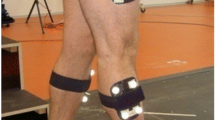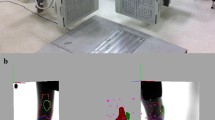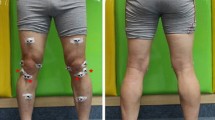Abstract
Purpose
To analyze the in vivo kinematics and arthrokinematics of chronic ACL-deficient (ACL-D) and unaffected contralateral knees during level walking and downhill running using dynamic biplane radiography. It was hypothesized that ACL-D knees would demonstrate increased anterior translation and internal rotation, and that ACL-deficiency would alter the tibiofemoral contact paths in comparison to the unaffected contralateral side.
Methods
Eight participants with unilateral chronic ACL-D without instability symptoms were recruited. The contralateral unaffected knee was considered as control. Kellgren–Lawrence (K–L) grades were determined from ACL-D and unaffected knees. Dynamic knee motion was determined from footstrike through the early-stance phase (20–25% of gait cycle) using a validated volumetric model-based tracking process that matched subject-specific CT bone models to dynamic biplane radiographs. Participants performed level walking at 1.2 m/s and downhill running at 2.5 m/s while biplane radiographs were collected at 100 and 150 images per second, respectively. Tibiofemoral kinematics and arthrokinematics (the path of the closest contact point between articulating subchondral bone surfaces) were determined and compared between ACL-D and unaffected knees. A two-way repeated measures analysis of variance was used to identify differences between ACL-D and unaffected knees at 5% increments of the gait cycle.
Results
Anterior–posterior translations were significantly larger in ACL-D than unaffected knees during level walking (all p < 0.001) and downhill running (all p ≤ 0.022). Internal rotation showed no significant difference between ACL-D and unaffected knees during level walking and downhill running. Closest contact points on the femur in ACL-D knees were consistently more anterior in the lateral compartment during downhill running (significant from 10 to 20% of the gait cycle, all p ≤ 0.044), but not during level walking. No differences in medial compartment contact paths were identified. Half of the participants had asymmetric K–L grades, with all having worse knee OA in the involved knee. Only 2 relatively young individuals had not progressed beyond stage 1 in either knee.
Conclusion
The results suggest that anterior translation and knee joint contact paths are altered in ACL-D knees even in the absence of instability symptoms. The clinical relevance is that ACL-D patients who do not report symptoms of instability likely still demonstrate altered knee kinematics and arthrokinematics compared to their uninvolved limb.
Level of evidence
Case–control study, Level III.





Similar content being viewed by others
References
Ahn JH, Bae TS, Kang KS, Kang SY, Lee SH (2011) Longitudinal tear of the medial meniscus posterior horn in the anterior cruciate ligament-deficient knee significantly influences anterior stability. Am J Sports Med 39:2187–2193
Amis AA, Dawkins GP (1991) Functional anatomy of the anterior cruciate ligament. Fibre bundle actions related to ligament replacements and injuries. J Bone Joint Surg Br 73:260–267
Anderst W, Zauel R, Bishop J, Demps E, Tashman S (2009) Validation of three-dimensional model-based tibio-femoral tracking during running. Med Eng Phys 31:10–16
Andriacchi TP, Briant PL, Bevill SL, Koo S (2006) Rotational changes at the knee after ACL injury cause cartilage thinning. Clin Orthop Relat Res 442:39–44
Andriacchi TP, Dyrby CO (2005) Interactions between kinematics and loading during walking for the normal and ACL deficient knee. J Biomech 38:293–298
Andriacchi TP, Mundermann A, Smith RL, Alexander EJ, Dyrby CO, Koo S (2004) A framework for the in vivo pathomechanics of osteoarthritis at the knee. Ann Biomed Eng 32:447–457
Defrate LE, Papannagari R, Gill TJ, Moses JM, Pathare NP, Li G (2006) The 6 degrees of freedom kinematics of the knee after anterior cruciate ligament deficiency: an in vivo imaging analysis. Am J Sports Med 34:1240–1246
Dennis DA, Mahfouz MR, Komistek RD, Hoff W (2005) In vivo determination of normal and anterior cruciate ligament-deficient knee kinematics. J Biomech 38:241–253
Fuentes A, Hagemeister N, Ranger P, Heron T, de Guise JA (2011) Gait adaptation in chronic anterior cruciate ligament-deficient patients: pivot-shift avoidance gait. Clin Biomech (Bristol Avon) 26:181–187
Gabriel MT, Wong EK, Woo SL, Yagi M, Debski RE (2004) Distribution of in situ forces in the anterior cruciate ligament in response to rotatory loads. J Orthop Res 22:85–89
Galway HR, MacIntosh DL (1980) The lateral pivot shift: a symptom and sign of anterior cruciate ligament insufficiency. Clin Orthop Relat Res 147:45–50
Gao B, Zheng NN (2010) Alterations in three-dimensional joint kinematics of anterior cruciate ligament-deficient and -reconstructed knees during walking. Clin Biomech (Bristol Avon) 25:222–229
Georgoulis AD, Papadonikolakis A, Papageorgiou CD, Mitsou A, Stergiou N (2003) Three-dimensional tibiofemoral kinematics of the anterior cruciate ligament-deficient and reconstructed knee during walking. Am J Sports Med 31:75–79
Grood ES, Suntay WJ (1983) A joint coordinate system for the clinical description of three-dimensional motions: application to the knee. J Biomech Eng 105:136–144
Hoshino Y, Kuroda R, Nagamune K, Araki D, Kubo S, Yamaguchi M et al (2012) Optimal measurement of clinical rotational test for evaluating anterior cruciate ligament insufficiency. Knee Surg Sports Traumatol Arthrosc 20:1323–1330
Hurd WJ, Axe MJ, Snyder-Mackler L (2008) A 10-year prospective trial of a patient management algorithm and screening examination for highly active individuals with anterior cruciate ligament injury: Part 1, outcomes. Am J Sports Med 36:40–47
Iliopoulos E, Galanis N, Iosifidis M, Zafeiridis A, Papadopoulos P, Potoupnis M et al (2017) Anterior cruciate ligament deficiency reduces walking economy in “copers” and “non-copers”. Knee Surg Sports Traumatol Arthrosc 25:1403–1411
Jonsson H, Riklund-Ahlstrom K, Lind J (2004) Positive pivot shift after ACL reconstruction predicts later osteoarthrosis: 63 patients followed 5–9 years after surgery. Acta Orthop Scand 75:594–599
Kuster M, Wood GA, Sakurai S, Blatter G (1994) 1994 Nicola Cerulli Young Researchers Award. Downhill walking: a stressful task for the anterior cruciate ligament? A biomechanical study with clinical implications. Knee Surg Sports Traumatol Arthrosc 2:2–7
Li G, Moses JM, Papannagari R, Pathare NP, DeFrate LE, Gill TJ (2006) Anterior cruciate ligament deficiency alters the in vivo motion of the tibiofemoral cartilage contact points in both the anteroposterior and mediolateral directions. J Bone Joint Surg Am 88:1826–1834
Li K, Zheng L, Tashman S, Zhang X (2012) The inaccuracy of surface-measured model-derived tibiofemoral kinematics. J Biomech 45:2719–2723
Lohmander LS, Ostenberg A, Englund M, Roos H (2004) High prevalence of knee osteoarthritis, pain, and functional limitations in female soccer players twelve years after anterior cruciate ligament injury. Arthritis Rheum 50:3145–3152
Marsh CA, Martin DE, Harner CD, Tashman S (2014) Effect of posterior horn medial meniscus root tear on in vivo knee kinematics. Orthop J Sports Med 2:2325967114541220
Marx RG, Jones EC, Angel M, Wickiewicz TL, Warren RF (2003) Beliefs and attitudes of members of the American Academy of Orthopaedic Surgeons regarding the treatment of anterior cruciate ligament injury. Arthroscopy 19:762–770
Miyaji T, Gamada K, Kidera K, Ikuta F, Yoneta K, Shindo H et al (2012) In vivo kinematics of the anterior cruciate ligament deficient knee during wide-based squat using a 2D/3D registration technique. J Sports Sci Med 11:695–702
Nagai K, Gale T, Herbst E, Tashiro Y, Irrgang JJ, Tashman S et al. (2017) Knee hyperextension does not adversely affect dynamic in vivo kinematics after anterior cruciate ligament reconstruction. Knee Surg Sports Traumatol Arthrosc. http://dx.doi.org/10.1007/s00167-017-4653-0
Noyes FR, Matthews DS, Mooar PA, Grood ES (1983) The symptomatic anterior cruciate-deficient knee. Part II: the results of rehabilitation, activity modification, and counseling on functional disability. J Bone Joint Surg Am 65:163–174
Okazaki K, Tashiro Y, Izawa T, Matsuda S, Iwamoto Y (2012) Rotatory laxity evaluation of the knee using modified Slocum’s test in open magnetic resonance imaging. Knee Surg Sports Traumatol Arthrosc 20:679–685
Risberg MA, Moksnes H, Storevold A, Holm I, Snyder-Mackler L (2009) Rehabilitation after anterior cruciate ligament injury influences joint loading during walking but not hopping. Br J Sports Med 43:423–428
Rosenberg A, Mikosz R, Mohler C (1994) Basic knee biomechanics. In: Scott N (ed) Mosby, St Louis, pp 75–94
Sakane M, Fox RJ, Woo SL, Livesay GA, Li G, Fu FH (1997) In situ forces in the anterior cruciate ligament and its bundles in response to anterior tibial loads. J Orthop Res 15:285–293
Shabani B, Bytyqi D, Lustig S, Cheze L, Bytyqi C, Neyret P (2015) Gait changes of the ACL-deficient knee 3D kinematic assessment. Knee Surg Sports Traumatol Arthrosc 23:3259–3265
Sim JA, Gadikota HR, Li JS, Li G, Gill TJ (2011) Biomechanical evaluation of knee joint laxities and graft forces after anterior cruciate ligament reconstruction by anteromedial portal, outside-in, and transtibial techniques. Am J Sports Med 39:2604–2610
Slocum DB, Larson RL (2007) Rotatory instability of the knee: its pathogenesis and a clinical test to demonstrate its presence. 1968. Clin Orthop Relat Res 454:5–13 (discussion 13–14)
Takeda K, Hasegawa T, Kiriyama Y, Matsumoto H, Otani T, Toyama Y et al (2014) Kinematic motion of the anterior cruciate ligament deficient knee during functionally high and low demanding tasks. J Biomech 47:2526–2530
Tashiro Y, Okazaki K, Miura H, Matsuda S, Yasunaga T, Hashizume M et al (2009) Quantitative assessment of rotatory instability after anterior cruciate ligament reconstruction. Am J Sports Med 37:909–916
Tashman S, Collon D, Anderson K, Kolowich P, Anderst W (2004) Abnormal rotational knee motion during running after anterior cruciate ligament reconstruction. Am J Sports Med 32:975–983
Tashman S, Kolowich P, Collon D, Anderson K, Anderst W (2007) Dynamic function of the ACL-reconstructed knee during running. Clin Orthop Relat Res 454:66–73
Waite JC, Beard DJ, Dodd CA, Murray DW, Gill HS (2005) In vivo kinematics of the ACL-deficient limb during running and cutting. Knee Surg Sports Traumatol Arthrosc 13:377–384
Yagi M, Wong EK, Kanamori A, Debski RE, Fu FH, Woo SL (2002) Biomechanical analysis of an anatomic anterior cruciate ligament reconstruction. Am J Sports Med 30:660–666
Yamaguchi S, Gamada K, Sasho T, Kato H, Sonoda M, Banks SA (2009) In vivo kinematics of anterior cruciate ligament deficient knees during pivot and squat activities. Clin Biomech (Bristol Avon) 24:71–76
Yim JH, Seon JK, Kim YK, Jung ST, Shin CS, Yang DH et al (2015) Anterior translation and rotational stability of anterior cruciate ligament-deficient knees during walking: speed and turning direction. J Orthop Sci 20:155–162
Zabala ME, Favre J, Andriacchi TP (2015) Relationship between knee mechanics and time since injury in ACL-deficient knees without signs of osteoarthritis. Am J Sports Med 43:1189–1196
Acknowledgements
This study was supported by the University of Pittsburgh Department of Orthopaedic Surgery. Dr. Lynch’s effort on this project was supported by the Comprehensive Opportunities in Rehabilitation Research Training (CORRT) Program (National Institutes of Health—K12 HD05931).
Author information
Authors and Affiliations
Contributions
CY performed data processing and analysis, and drafted the manuscript. YT assisted in data analysis and revised the manuscript. AL revised the manuscript and provided clinical interpretation of the results. FF contributed to drafting and revision of the manuscript and provided clinical interpretation of the results. WA contributed to data processing and data analysis, drafting and revision of the manuscript, and biomechanical interpretation of the results.
Corresponding author
Ethics declarations
Conflict of interest
The authors declare that they have no conflict of interest.
Funding
Funding was provided by the University of Pittsburgh Department of Orthopaedic Surgery.
Ethical approval
The study was approved by the Institutional Review Board of the University of Pittsburgh (PRO 08030126).
Informed consent
All participants signed informed consent forms prior to participating in this IRB-approved study (PRO08030126).
Rights and permissions
About this article
Cite this article
Yang, C., Tashiro, Y., Lynch, A. et al. Kinematics and arthrokinematics in the chronic ACL-deficient knee are altered even in the absence of instability symptoms. Knee Surg Sports Traumatol Arthrosc 26, 1406–1413 (2018). https://doi.org/10.1007/s00167-017-4780-7
Received:
Accepted:
Published:
Issue Date:
DOI: https://doi.org/10.1007/s00167-017-4780-7




